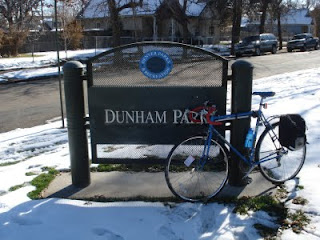A week ago, I had the opportunity to try biking to Denver's airport. Leading up to this ride, I scoured blogs, emails, and mailing lists for accounts of riding to DIA, but to no avail.
I
know I read something last year about somebody commuting to DIA on
BTWD. But now, I was unable to turn anything up.
And so now, I write! Denverites, if you are contemplating a ride to the airport, read on!
There was a needlessly complicated series of events that resulting in me needing to drop off a car at the airport and then find some other way to get home.
I elected to
bike it up!I had been itching to try this ride. Access to an airport has come to stand in my mind as a great measure of a city's bike-ability.
And Denver must have one of the least accessible airports in the nation.
Or maybe I'm just prejudiced by the fact that I lived in San Diego for so long, where you can literally walk to the airport from downtown.
Denver International Airport is
on my bike map now. It was a 2 hour ride, but I proclaim it Bike-able.
Two portions of the ride warrant elaboration.
The first is Pena/Airport Boulevard, and the second is Copper Flats/Meadows MHC.
Pena/Airport Boulevard
Holy crap, this leg of the ride a white-knuckle Fright Fest.
First of all, Pena Blvd is a designated bike route.
You'll see a lot of the "DIA Bike Route" sign.

I don't know why it's reassuring, but it is. At least you know, I guess, that you're not doing anything illegal.
Because it does feel like you shouldn't be allowed to bike on Pena. Cars are whizzing by at 70+ MPH. You're basically riding your bike on the interstate.

Or, on an interstate highway with an extra wide shoulder designated as a bike lane.
The shoulder is nice, smooth, maintained as a bike path, and always
at least one full car lane in width.
It feels adequately safe.
Until you start riding through shreds of rubber, and you realize that a poorly timed blow-out would send a passing car hurtling into you at Instant Death speeds.
So you throttle and choke your handlebars, and you coach yourself through breathing a lot.
And navigating exit/entrance ramps is challenging. You basically have to stop and dismount, and walk across the ramps. Because you can't really assess the intent of approaching cars while you are moving: Exiting? Not exiting? Blinker on by accident? Exiting without using blinker? Just can't tell at these speeds!
Riding Pena might sound scary.
That's because it is scary.
But it's doable. I'd do it again if I had to.
Copper Flats/Meadows MHC
About 12 miles from DIA is the intersection of East 13th Avenue and Sable Boulevard. Riding away from the airport, your route carries you south on Sable, and then west on 13th, at which point you encounter something a little surreal.
When you turn onto 13th, you quickly find yourself in the middle of Meadows MHC (Mobile Home Community). It's a cute-as-hell little trailer park.
Seriously, there are some neat looking mobile homes, the owners of which are obviously quite proud.
But then after only a few blocks, 13th suddenly dead ends at a chain link fence.
Just as you're about to omfg and pull on the brakes, you see a little slit in the fence, and you see a narrow strip of asphalt continue across a meadow.
So you continue through the fence, into the meadow, and suddenly you're in a crazy No Man's Land.
There's broken glass on the strip of a trail. There's a discouraged looking vagrant pushing a shopping cart across the meadow. Prairie dogs are dodging, ducking, dipping, diving, and dodging. And barking at everything that moves. A couple of bedraggled leathernecks in wife-beaters are drinking beer at 10:00 AM, looking at you with their eyes. Hard.
Then you go under I-225 and suddenly you're at another chain-link fence at Tollgate Creek.

So you continue through another gap in another fence, across this funny little foot bridge, and you emerge on the other side ...

In
Copper Flats. A swanky, gated community with a clubhouse and a pool and parking and a flashy website.
And you can't help but assume that at night, the Copper Flats kids and the Meadows Trailer Park kids meet in the barren Prairie Dog meadow and have monkey knife fights in the light of the moon.







































